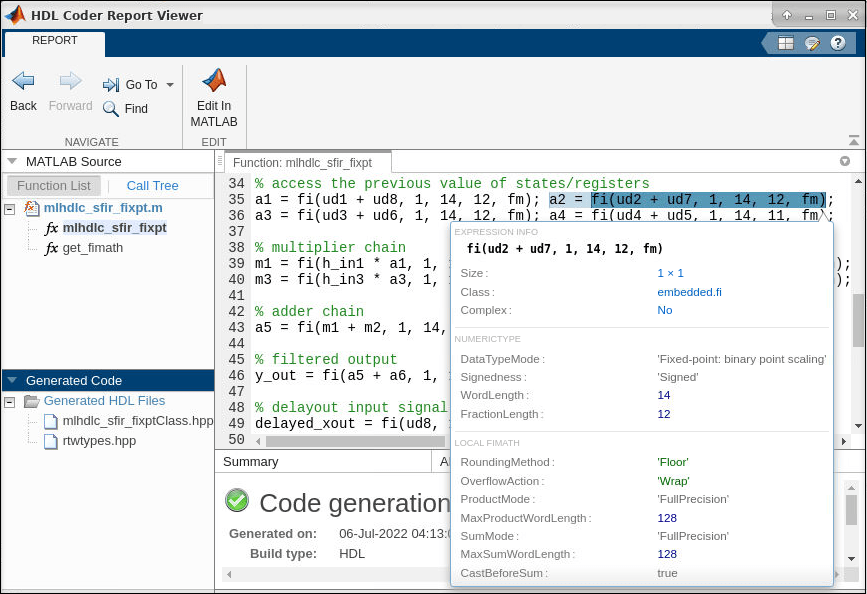Get Started with MATLAB to High-Level Synthesis Workflow Using the Command Line Interface
This example shows how to use the HDL Coder™ command-line interface to generate High-Level Synthesis (HLS) code from MATLAB® code, including floating-point to fixed-point conversion.
Overview
High-Level Synthesis (HLS) code generation using the command-line interface has the following basic steps:
Set up the HLS tool path for HLS code generation by using the function
hdlsetuphlstoolpath.Create a
fixptcoder configuration object.Create an
hdlcoder configuration object.Set configuration object parameters.
Run the
codegencommand to generate HLS code.
The HDL Coder command-line interface can use two coder configuration objects with the codegen command. The fixpt coder configuration object configures the floating-point to fixed-point conversion of your MATLAB code. The hdl coder configuration object configures HLS code generation and programming options.
The example code implements a simple symmetric finite impulse response (FIR) filter and its test bench. Using this example, you can configure floating-point to fixed-point conversion and generate HLS code.
Create Floating-Point to Fixed-Point Conversion Configuration Object
If your design already uses fixed-point types and functions, then you can skip the fixed-point conversion step.
To perform floating-point to fixed-point conversion, you need a fixpt configuration object.
Create a fixpt configuration object and specify your test bench name.
fixptcfg = coder.config('fixpt'); fixptcfg.TestBenchName = "mlhdlc_sfir_tb";
Fixed-Point Conversion Type Proposal Options
The code generator can propose fixed-point types based on your choice of either word length or fraction length. These two options are mutually exclusive.
Base the proposed types on a word length of 24:
fixptcfg.DefaultWordLength = 24; fixptcfg.ProposeFractionLengthsForDefaultWordLength = true;
Alternatively, you can base the proposed fixed-point types on fraction lengths. The following code configures the code generator to propose types based on a fraction length of 10:
fixptcfg.DefaultFractionLength = 10; fixptcfg.ProposeWordLengthsForDefaultFractionLength = true;
Safety Margin
The code generator increases the simulation data range on which it bases its fixed-point type proposal by the safety margin percentage. For example, the default safety margin is 4, which increases the simulation data range used for fixed-point type proposal by 4%.
Set the SafetyMargin to 10%:
fixptcfg.SafetyMargin = 10;
Data Logging
The code generator runs the test bench with the design before and after a floating-point to fixed-point conversion. You can enable simulation data logging to plot the quantization effects of the new fixed-point data types.
Enable data logging in the fixpt configuration object:
fixptcfg.LogIOForComparisonPlotting = true;
Numeric Type Proposal Report
Configure the code generator to start the type proposal report once the fixed-point types have been proposed:
fixptcfg.LaunchNumericTypesReport = true;
Create HLS Code Generation Configuration Object
To generate HLS code, you must create an hdl configuration object and set your test bench name:
hdlcfg = coder.config('hdl'); hdlcfg.TestBenchName = "mlhdlc_sfir_tb";
Target Language and Synthesis Tool
To generate HLS code, specify the workflow as High Level Synthesis and the synthesis tool.
hdlcfg.Workflow = "High Level Synthesis"; hdlcfg.SynthesisTool = "Cadence Stratus HLS"; % or "Xilinx Vitis HLS"
Generation of HLS Test Bench Code
Configure the code generator to generate a HLS test bench from your MATLAB® test bench:
hdlcfg.GenerateHDLTestBench = true;
Simulation of the Generated HLS Code
If you want to simulate your generated HLS code, you must also configure the code generator to generate a HLS test bench.
hdlcfg.SimulateGeneratedCode = true;
Synthesis Tool for Generated HLS Code
You can synthesize your generated HLS code by using the synthesis tool. Configure the code generator to use this tool.
hdlcfg.SynthesizeGeneratedCode = true;
Run HLS Code Generation
Now that you have your fixpt and hdl configuration objects set up, run the codegen command to perform floating-point to fixed-point conversion and generate HLS code:
codegen -float2fixed fixptcfg -config hdlcfg mlhdlc_sfir -report
HLS Code Generation Report
At the MATLAB® command line window, you can check the code generation report by clicking View Report.
The code generation report helps you to:
Debug code generation issues and verify that your MATLAB code is suitable for code generation.
View generated HLS code.
Access additional reports like a conformance report and resource utiliztion report.
See how the code generator determines and propagates type information for variables and expressions in your MATLAB code.
To view a MATLAB function in the code pane, click the name of the function in the MATLAB Source pane. In the code pane, when you pause on a variable or expression, a tooltip displays information about its size, type, and complexity.
For more information see, HLS Code Generation Report.

Limitations
Cadence Stratus HLS supports only point to point (p2p) communication for HLS code generation.
Generating HLS code that runs on multiple threads is not supported.
System object™ are not supported for HLS code generation.
Array of structures, enumerations, and classes are not supported as inputs and outputs at the top-level DUT ports for HLS code generation.